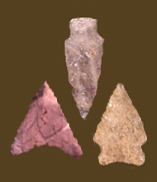
|
LAMOKA Defining Attributes Chronology The Lamoka point dates to the Late Archaic period. Ritchie (1971) states that the point is a defining artifact of the Lamoka complex in New York, for which radiocarbon dates ranging between 5500 and 4500 BP (approximately 4350-3250 BC in calendar years) have been obtained, but in the Upper Susquehanna River valley, Funk (1993) says Lamoka assemblages are well-dated between 4500 and 3900 BP (3250-2400 BC in calendar years). Wall et al. (1996) suggest a range of 4000 to 3600 BP (2550-1900 BC) in Pennsylvania. At the Slade site along the Nottoway River in Virginia, McAvoy and McAvoy (1997) recovered Lamoka points in a context stratigraphically dated to approximately 4500 BP (3250 BC). Ritchie (1971) suggests the point continued in small quantities into the Middle Woodland period. Description Blade: The blade is elongated and triangular, and thick. In cross section it is biconvex or median ridged. The edges are straight or slightly excurvate. Haft Element: The base may be straight, oblique, or slightly convex-to-bulbous. It is usually un-worked and as thick as the blade, often exhibiting a broad, slightly modified or unmodified surface of the original bulb of percussion. The “unfinished” condition of the base is a key diagnostic feature of the Lamoka point. Basal grinding occurs occasionally. The stem may be straight and of moderate length, or slightly side notched. Size: Length ranges from 20 to 70 mm. Width ranges from 10 to 24 mm. Thickness measures 6 to 12 mm. At the Warwick site in Cecil County, MD., eight complete Lamoka points ranged from 27.7 to 38.0 mm in length, 15.9 to 17.9 mm in width, and 4.7 to 8.1 mm in thickness (Klein et al. 2014). Technique of manufacture: Crudely made by soft percussion, with little or no pressure retouching. Material: In the area surrounding Zekiah Swamp on the lower Potomac, Wanser (1982) found that 45% of 83 Lamoka points were quartz, with 35% rhyolite and 20% quartzite. Lamokas found in the middle Potomac River Valley are made of local materials such as rhyolite, quartzite, and quartz (Hranicky 2002). At the Warwick site in Cecil County, MD, 66% of the 15 Lamoka points found were made of jasper (Klein et al. 2014). Discussion Defined in Literature Other Names Used References |
![]()
Search by Shape:
(See Projectile Point Typology) |

|
Thank you for visiting our website. If you have any
questions, comments, Copyright © 2002 by |

|

